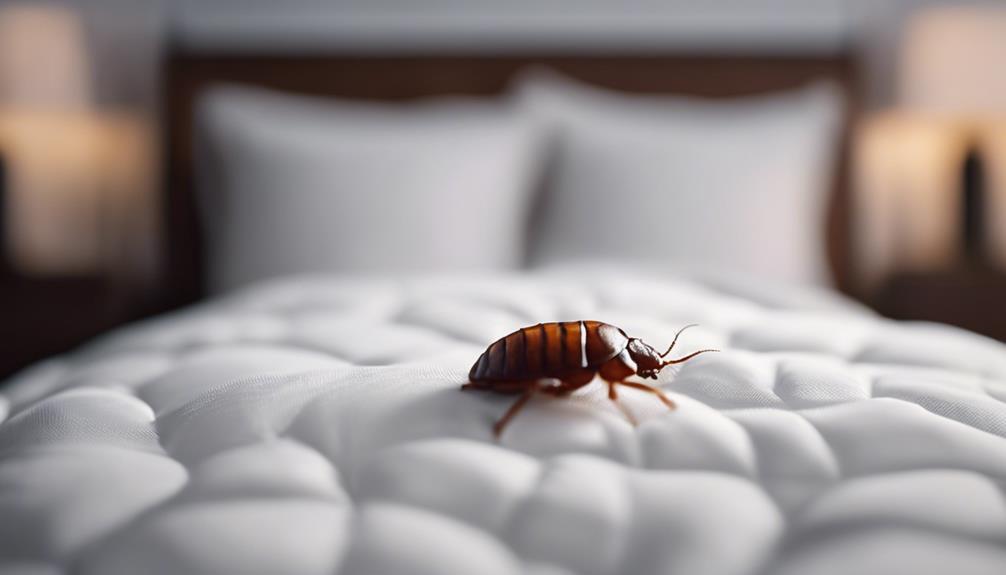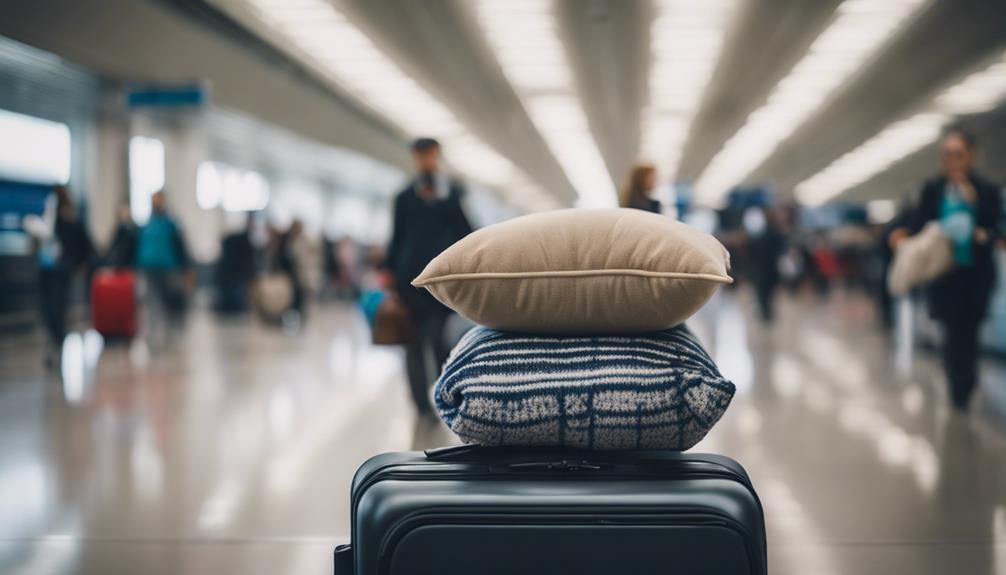Yes, comforters can contain bed bugs in their fabric, seams, and folds. These small insects survive on human blood and are most effectively eradicated by using high heat treatment in the dryer. Temperatures exceeding 120°F for 30 minutes kill bed bug eggs, nymphs, and adults efficiently. It is vital to regularly check for indicators like bloodstains and eggshells. Washing in hot water and drying at high heat can aid in getting rid of bed bugs. Keeping clean comforters sealed in plastic bags can prevent re-infestation. To ensure a bed bug-free space, consider investing in protective encasements made of bed bug-resistant materials. Protect yourself from infestations successfully.
Key Takeaways
- Bed bugs infest comforters in seams, folds, and fabric.
- Washing in hot water and high heat drying kills bed bugs.
- Sealing clean comforters in plastic bags prevents re-infestation.
- Regularly inspect for signs like bloodstains and small insects.
- Use protective encasements to create a bed bug barrier.
Understanding Bed Bugs in Comforters

When it comes to understanding bed bugs in comforters, it's crucial to recognize that these pests can easily infest and hide within the fabric, seams, and folds of the bedding. Bed bugs are tiny insects that feed on human blood and are skilled at finding cozy spots to nest, making comforters an ideal environment for them to lay eggs and thrive.
To combat bed bugs in comforters, utilizing high heat treatment in the dryer is a highly effective method to kill bed bug eggs, nymphs, and adults. By subjecting the comforter to temperatures above 120°F for at least 30 minutes, you can guarantee that the entire infestation is eradicated. High heat is a natural and chemical-free approach that's safe for most comforter materials.
It's important to remember that sealing clean comforters in durable plastic bags can also provide protection against bed bug infestations, preventing these pests from infiltrating your bedding and causing further issues.
Signs of Bed Bug Infestation

To detect a bed bug infestation in your comforter, carefully inspect for small, flat insects, droppings, bloodstains, red or brown stains, ivory-colored eggshells, live bed bugs, or dark brown fecal spots.
Look closely at the seams and folds of the comforter where bed bugs like to hide. If you notice tiny insects resembling apple seeds, dark spots or smears that could be bed bug feces, or red and brown stains that might be blood from crushed bugs, these could all be signs of a bed bug infestation.
Additionally, ivory-colored eggshells or live bed bugs near areas where you sleep are strong indicators of a problem. Pay attention to any itchy red skin or bite marks you might've after using the comforter, as these could also signal the presence of bed bugs.
Regularly checking for these signs can help you catch a bed bug infestation early and take appropriate action to address the issue promptly.
Prevention Tips for Comforters

Wondering how to keep your comforter free from bed bugs? To prevent a bed bug infestation in your comforter, there are several proactive steps you can take.
First, regularly inspect your comforter for any signs of bed bugs, such as small reddish-brown stains or tiny dark spots that could indicate their presence. Washing your comforter in hot water and drying it on high heat can help eliminate any potential bed bugs and their eggs. Additionally, sealing your clean comforter in a plastic bag after washing can help reduce the risk of re-infestation.
It's also essential to keep your sleeping area clean and clutter-free, as bed bugs thrive in messy environments. By regularly cleaning your bedding, vacuuming your mattress and bed frame, and minimizing hiding spots for bed bugs, you can significantly lower the likelihood of an infestation in your comforter.
Washing and Treating Infested Comforters

If comforters become infested with bed bugs, the most effective way to eliminate them is by washing the comforter in hot water and drying it on high heat. Heat is bed bugs' worst enemy, as it kills them at all stages of life – eggs, nymphs, and adults. Here is a simple guide to help you effectively wash and treat an infested comforter:
| Steps to Wash and Treat Infested Comforters |
|---|
| 1. Wash the comforter in hot water |
| 2. Dry the comforter on high heat |
| 3. Seal the clean comforter in a durable plastic bag to prevent re-infestation |
When dealing with bed bugs, it's important to remember that washing and drying alone may not be enough. Make sure to also inspect your bed bug mattress and surrounding areas for any signs of infestation. If the problem persists, seeking professional help is the best course of action to ensure thorough removal and treatment.
Using Protective Encasements for Comforters

When seeking additional protection against bed bug infestations in comforters, consider using protective encasements made of durable, bed bug-proof materials. These encasements act as a barrier that makes it difficult for bed bugs to penetrate and hide in the comforter, providing a proactive approach to preventing infestations.
Typically crafted from sturdy, bed bug-proof fabrics, these encasements offer a reliable shield for your comforter. By investing in encasements for your comforters, you can enjoy peace of mind knowing that your bedding is safeguarded against potential bed bug problems.
Remember to regularly inspect and clean encased comforters to maintain a bed bug-free environment effectively. This simple step can greatly contribute to the longevity of your comforter and ensure a hygienic sleeping space.
Frequently Asked Questions
How Can I Tell if My Bedding Has Bed Bugs?
To determine if your bedding has bed bugs, look for brown or red stains, which are droppings and blood respectively. Check for small, flat insects or shed skins. A musty odor and red, itchy bites may also indicate their presence.
If you suspect bed bugs, consider professional inspection and treatment. DIY methods may not completely eliminate the infestation. It's vital to act promptly to prevent further spread and discomfort.
Should I Throw Away My Pillows if I Have Bed Bugs?
If bed bugs infest your pillows, addressing the issue promptly is crucial. Inspect for signs like dark spots, eggs, or live bugs.
Consider professional pest control for effective treatment. Throwing away pillows may not be necessary; proper treatment and encasement can prevent spread and reinfestation.
Act swiftly to control the situation and protect against further bed bug problems.
How Do I Protect My Bed Bugs From My Bedding?
To safeguard bedding from bed bugs, we recommend a proactive approach. Start by regularly washing and drying your bedding on high heat to kill any potential bugs or eggs.
Additionally, seal clean bedding in durable plastic bags to prevent reinfestation. Avoid using insecticide sprays, as they may not be effective and could harm the fabric.
Taking these preventive steps can help protect your bedding from bed bugs and guarantee a restful night's sleep.
How Do You Get Bed Bugs Out of Blankets?
To get bed bugs out of blankets, we recommend placing the blanket in the dryer on high heat. This will effectively kill eggs, nymphs, and adult bed bugs.
After treatment, seal the clean blanket in a durable plastic bag to prevent reinfestation.
Avoid using insecticide sprays as they can be ineffective and leave stains and odors.
For challenging infestations, seek professional pest control help for thorough removal.
Are Comforters a Common Hiding Place for Bed Bugs?
Yes, comforters are a common hiding place for bed bugs. These pesky insects can easily burrow into the folds and seams of the fabric, making it difficult to spot them. Combating bed bug infestations requires thorough cleaning and regular inspections of bedding and furniture.
Conclusion
To sum up, comforters can indeed attract bed bugs if not properly cared for. Just like a cozy blanket that keeps us warm, comforters can unknowingly harbor these pesky pests.
By being vigilant for signs of infestation, practicing prevention techniques, and washing and treating infested comforters promptly, we can guarantee a bed bug-free sleep environment.
Remember, just as we take care of ourselves, it's important to also take care of our bedding to keep those bed bugs at bay.










